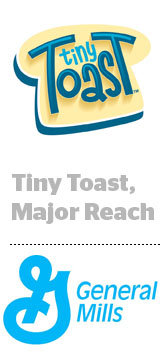 When General Mills launched Tiny Toast in June, its first new cereal brand in more than 15 years, the company also launched its first completely digital marketing campaign.
When General Mills launched Tiny Toast in June, its first new cereal brand in more than 15 years, the company also launched its first completely digital marketing campaign.
Because General Mills was targeting millennials, it stayed away from traditional TV and instead placed short video clips across YouTube, Snapchat and Instagram. In the two months since its launch, the campaign has only racked up about a million YouTube views. But because these videos were organically shared across social platforms, the campaign saw 700 million earned impressions within the first week.
“In all of the TV watched by young adults, only 25% is watched on an actual TV,” said Alan Cunningham, senior marketing manager of cereal innovation at General Mills. “Everything else is on a mobile device or computer. So that really struck us and we said we have to diversify our approach and our content to speak to them where they are.”
But cross-platform campaigns are difficult because social channels have distinct formats. So General Mills filmed custom video content for each vertical.
That took a lot more production work than a traditional campaign launch, Cunningham said.
“Ten years ago, [you] started with a TV spot and figured out how to adapt it,” he said. “We wanted different content that would come to life in different verticals.”
That meant filming vertical cuts for Snapchat, more polished takes for Instagram and short, engaging clips for YouTube. General Mills’ creative agency, Walrus, edited the videos so the food giant could reuse content across platforms.
Once the content went live, General Mills tapped influencers on Tumblr to get the word out by posting reviews. Fans shared their own experiences with Tiny Toast on the platform, as well as GIFs and other content repurposed from the clips. General Mills offered coupons and other offers on Tumblr to drive purchase intent.
Ensuring that all this different content cohered took more collaboration across General Mills’ marketing teams than in previous campaigns, Cunningham said.
“Instead of going off in silos and working on things, every day we talked and said, ‘How do we make this work together?’” he said. “There was an extra amount of collaboration to make sure the work we did was complementary.”
General Mills used its first-party data to target known customers across platforms. It targeted prospects who showed high activity with product categories that have strong affinities to cereal. Third-party data from Nielsen Catalina gave insight into in-store activity, such as point-of-sale data, to target prospects already purchasing similar fruity cereals.
General Mills hasn’t yet measured the results of the campaign, but it will start by looking at bottom-funnel metrics like sales to repeat buyers. It is, however, difficult to measure total campaign success, said Cunningham, because platform metrics like video views and completion rates vary by channel.
“It’s many more metrics were used to looking at in the past,” Cunningham said. “They are by vehicle and a little fuzzier than we’d like.”
He pointed to Snapchat as a challenging platform to measure because it doesn’t yet have specific data points or pure reporting around media effectiveness.
“What comes with Snapchat is still a lot of question marks,” he said.
Mindshare, the company’s media agency, will help General Mills analyze campaign data and direct spend toward the most successful channels.
General Mills will consider expanding its Tiny Toast advertising to more traditional channels like linear TV, as research shows the brand resonates with demographics beyond millennials. But for now, Tiny Toast hasn’t yet maximized its opportunities on digital, Cunningham said.
“We feel like we could do a lot more in digital and social channels and spend more.”













